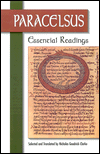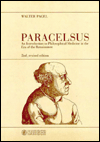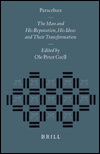Paracelsus (1493-1541)


 Paracelsus
supported himself by his medical practice, but he led a highly itinerant
life, as a result of his great capacity for making enemies. He was
employed as a military surgeon in the Venetian service in 1522. From the
fact that Paracelsus appears to have been very well travelled, it seems
probable that he was involved in the many wars waged between 1517 and 1524
in Holland, Scandinavia, Prussia, Tartary, the countries under Venetian
influence, and possibly the near East. After a series of abortive attempts
to establish a practice in southern Germany and Switzerland, he settled
in Strasbourg where he had a successful practice. In 1527, he was called
to Basel, where he was town physician with a rare commission and right
to lecture at the university, despite opposition from Galenists.
He was forced to leave after the death of his patron in 1528. Thereafter,
his life was a long journey interupted by short periods of residence in
southern Germany, Switzerland, Austria, and Bohemia.
Paracelsus
supported himself by his medical practice, but he led a highly itinerant
life, as a result of his great capacity for making enemies. He was
employed as a military surgeon in the Venetian service in 1522. From the
fact that Paracelsus appears to have been very well travelled, it seems
probable that he was involved in the many wars waged between 1517 and 1524
in Holland, Scandinavia, Prussia, Tartary, the countries under Venetian
influence, and possibly the near East. After a series of abortive attempts
to establish a practice in southern Germany and Switzerland, he settled
in Strasbourg where he had a successful practice. In 1527, he was called
to Basel, where he was town physician with a rare commission and right
to lecture at the university, despite opposition from Galenists.
He was forced to leave after the death of his patron in 1528. Thereafter,
his life was a long journey interupted by short periods of residence in
southern Germany, Switzerland, Austria, and Bohemia.
Although he seems never to have become a Protestant himself, despite the radical character of his theology and politics, many of his patrons and disciples were Protestants. At Strasbourg, Paracelsus relied for protection from his fellow physicians on the reformers: Nicolaus Gerbelius, Kaspar Hedio, and Wolfgang Capito. Capito had been in Basel earlier and was an intimate and old friend of Paracelsus's Basel patron, Oecolampadius. At Basel, Paracelsus successfully treated the leg of the publisher Froben, who was at the center of the humanist movement in Basel. This won Paracelsus the grateful recognition of Erasmus and the powerful Amerbach brothers. Paracelsus was at that time simply visiting Basel and Erasmus then expressed his desire to secure his services for Basel. Oecolampadius was responsible for Paracelsus's actual appointment. With Froben's death, Paracelsus lost a major protector, and the pressure against him increased. When Paracelsus insulted a judge after a prejudiced ruling against him, he was forced to leave town.
Paracelsus derided the use of guaiacum in the treatment of syphilis, claiming that its only benefit was to the coffers of the Fuggers, the imperial bankers who held the import monopoly on the drug. Paracelsus's planned printing of the Eight Books on the French Disease was banned due to a decree based on the opinion of the dean of the Leipzig medical faculty, Heinrich Strower, a friend and beneficiary of the Fugger family.
The alchemical and neo-Platonic principles on which Paracelsus based his medical and natural philosophical theories were anathema to orthodox Galenists and Aristotelians, but they proved attractive to those who sought inward illumination. Although many Paracelsian remedies were incorporated into the conventional pharmacopoeia, his mystical ideas were perhaps more significant, despite being influential mainly among small coteries, such as the semi-mythical Brotherhood of the Rosy Cross. Chemical physicians set up in competition with orthodox academic physicians and had considerable success, especially in the German lands, but the mystical ideas of Paracelsus had a following among radical Protestants of various kinds and were opposed by more orthodox Christians, both Protestant and Catholic. Whereas Calvinists looked to the Bible for ultimate authority and Catholics looked to the traditions of the Church, those who were attracted to Paracelsianism or its later development in the work of Jan Baptist van Helmont tended to be interested in inner illumination directly from God. This is why such groups as the Anabaptists and the Quakers found Paracelsian or Helmontian medicine attractive.
The universe as seen by Paracelsus was filled with correpondences and harmonies, so that what was above resonated with what was below, in the world or the human body. The mysteries of God's creation pervaded the mundane world, and could be utilized by the truly pious magician. His followers, such as Oswald Croll, developed a highly personal hermeneutic for reading both the Bible and God's book of nature, in ways that emphasized the mystical forces that pervaded the world. However, although paracelsus had no desire to strip the magical from the world, he did tend to explain unusual phenomena in terms of natural magic, rather than the demonic. He believed in the existence of witches, for example, but saw them as the product of evil planetary forces rather than Satan, who benefited from the evil impulses of humans rather than being their initiator. Paracelsus believed in the possibility of human improvement and the increase of knowledge, through divine help and personal dedication, so that his ideas became linked with the millenarian project to improve the world in preparation for the 1000-year rule of the saints and to unite all human knowledge in an encyclopaedic scheme.

Paracelsus, Prognosticatio [1536], print from an edition c.1570
An aspect of Paracelsus that fascinated late nineteenth-century occultists but has been rather neglected by historians so far is his prophetic impulse. The original edition of the Prognosticatio contained fairly crude woodcuts. As the fame of Paracelsus grew, better quality editions of some of his early works appeared. His prognostications consist of 32 symbolic images each with a short Latin caption. There is a short preface and a brief exposition at the end. The book was intended to prophesy world events during the subsequent 42 years.
Prophecy 26, above, shows a rose upon a crown. The text reads, "The Sybil hath been mindful of thee when she placed the ?F? and right well art thou now standing in the Rose; for thou art ripe and time hath brought thee. What the Sybil saith of thee shall be accomplished and even more shall be said of thee. The summer that bringeth roses is that contrary time wherein all things are divided: which is an indication that man was building on sand. This must pass away, and thou shalt set it upon the rock that many will be astounded. For when the time cometh, also there will come that wherefore the time hath come."
For a fuller discussion of his ideas, see the brief introduction to Paracelsus, by Allen Debus
Essay on Paracelsianism as a religion, by Carlos Gilly



Some of the works of Paracelsus, such as the Practica Teutsch, were published during the lifetime of Paracelsus, although he had repeated difficulties in finding printers able to publish his writings freely, so great was the opposition to his controversial views. After his death, his medical and natural philosophical works were published by Johann Huser, but most of the theological works have remained in manuscript until the present century. By fits and starts, these are now being edited and published by The Zurich Paracelsus Project, under the direction of Urs Leo Gantenbein.
German text of Volumen Medicinae Paramirum, online
German text of Archidoxis Theophrastiae, online
English translation from the Coelum Philosophorum, online
Paracelsus his Aurora, & Treasure of the Philosophers (London, 1659)
English translation of The Prognostications of Paracelsus, illustrated
Paracelsus has not been well served by his translators, who have often either been hostile or else enthusiasts for his work as a precursor of their own interests, in Jungian alchemical speculation or occultism.
 Nicholas
Goodrick-Clarke, Paracelsus: Essential Readings (Wellingborough,
1990)
Nicholas
Goodrick-Clarke, Paracelsus: Essential Readings (Wellingborough,
1990)
Paracelsus: Selected Writings, edited with an
introduction by Jolande Jacobi, translated by Norbert Guterman (New York,
1951)
Four Treatises of Theophrastus von Hohenheim Called
Paracelsus, edited, with a preface by Henry E. Sigerist (Baltimore,
1941; repr.1996)
Arthur Edward Waite, The Hermetic and Alchemical Writings
of Aureolus Phillippus Theophrastus Bombast, of Hoheneim, Called Paracelsus
the Great (2 vols., London, 1894).
Secondary works on Paracelsus and Paracelsianism
 Walter
Pagel, Paracelsus: An Introduction to Philosophical Medicine in the
Era of the Renaissance (Basel, 1968; second edition, 1982)
Walter
Pagel, Paracelsus: An Introduction to Philosophical Medicine in the
Era of the Renaissance (Basel, 1968; second edition, 1982)
Walter Pagel, The Smiling Spleen: Paracelsianism in
Storm and Stress (Basel, 1984)
Allen G. Debus, The English Paracelsians (London,
1965)
Allen G. Debus, The French Paracelsians: The Chemical
Challenge to Medical and Scientific Tradition in Early Modern France
(Cambridge, 1991)
Allen G. Debus, The Chemical Philosophy: Paracelsian
Science and Medicine in the Sixteenth and Seventeenth Centuries (2
vols., New York, 1977)
 Andrew
Weeks, Paracelsus: Speculative Theory and the Crisis of the Early Reformation
(Albany, 1997)
Andrew
Weeks, Paracelsus: Speculative Theory and the Crisis of the Early Reformation
(Albany, 1997)
Owen Hannaway, The Chemists and the Word: The Didactic
Origins of Chemistry (Baltimore, 1975)
Bruce T. Moran, The Alchemical World of the German
Court: Occult Philosophy and Chemical Medicine in the Circle of Moritz
of Hessen (1572-1632), Sudhoffs Archiv, Beiheft 29 (Stuttgart, 1991)
 Ole
Peter Grell, ed. Paracelsus: The Man and His Reputation, His Ideas,
and Their Transformation (Leiden, 1998)
Ole
Peter Grell, ed. Paracelsus: The Man and His Reputation, His Ideas,
and Their Transformation (Leiden, 1998)
Charles Webster, "Paracelsus: Medicine as Popular Protest,"
in Ole Peter Grell and Andrew Cunningham, eds. Medicine and the Reformation
(London, 1993)
The literature, especially in article form, is large and expanding. The History of Science, Medicine and Technology database, available online through ND Library, is recommended for further searches, especially on more specialized topics.